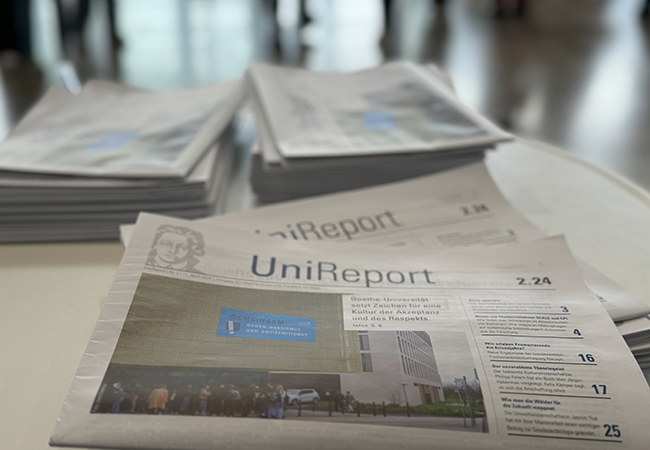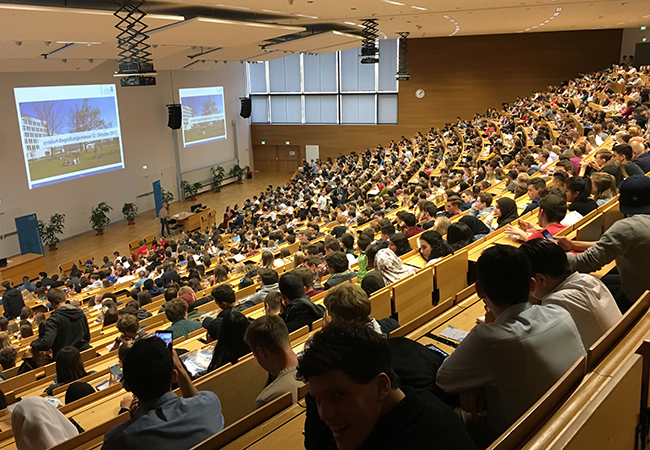
Gaining new insights into the structure and composition of matter and how elements such as gold were created in the universe are the research goals of the Collaborative Research Cluster ELEMENTS. Under the leadership of Goethe University Frankfurt, scientists will carry out experiments at particle accelerators and derive new theoretical models to describe the matter in extreme astrophysical objects such as neutron stars and understand the origin of heavy elements – such as gold and platinum – in the Universe. The Collaborative Research Cluster serves to prepare for the next round of the excellence strategy and is being funded by the state of Hessen, Goethe University and the co-applicants, Technische Universität Darmstadt, Justus-Liebig-Universität Giessen and GSI Helmholtzzentrum für Schwerionenforschung with a total of 16 million euros. In terms of research strategy, ELEMENTS builds on the close cooperation between Goethe University and TU Darmstadt in the network of Rhine-Main universities.
In 1054, Chinese astronomers reported a new star that was also visible during the day, but which disappeared again after some time. The celestial phenomenon was also described by a Flemish monk and other observers in Europe and Asia, as well as appearing in rock drawings by North American Indians. Almost 900 years later, astronomer Edwin Hubble attributed the Crab Nebula, a huge cloud of dust and gas in the constellation of Taurus, to a violent stellar explosion whose light had reached Earth in 1054 and was interpreted as a new star: a supernova. Supernovae occur at the end of the lifetime of very massive stars, when the nuclear fuel in their centre is exhausted. This causes the outward radiation pressure to decrease until finally the stellar core collapses under its own gravity. As a result, the matter inside becomes extremely compressed – down to the density of atomic nuclei – and produces a shock wave so that a large part of the star’s matter is blown away – this is how the Crab Nebula was formed, which is still expanding today at a speed of 1500 kilometres per second.
A neutron star remained at the centre of the supernova – an extremely dense object about 30 kilometres in diameter, in which a little more than one solar mass is compressed to an unimaginable degree: a cube of neutron star mass with an edge length of one centimetre would weigh 100 million tonnes on Earth. If the originating star is extremely large and has more than 40 solar masses, a black hole is created after it burns out. At its event horizon, a black hole generates such strong gravity that not even light can escape beyond the event horizon.
Colliding neutron stars
It is these extreme states of matter that make neutron stars and black holes so interesting for scientists in ELEMENTS. As an example of the extreme regimes that scientists in ELEMENTS will explore, when two neutron stars collide with each other, their matter may be compressed in such a way that the neutrons inside are dissolved into their elementary components, quarks and gluons. A similar quark-gluon plasma existed a fraction of a second after the Big Bang, and as the expanding universe cooled, quarks and gluons became confined into protons and neutrons, which in turn merged into atomic nuclei and atoms – the form of matter that planets and stars are predominantly made of today.
Among other things, researchers in ELEMENTS will investigate such phase transitions as they could provide precious information about why – when confined into hadrons –quarks only ever appear in pairs or groups, but never alone. For this reason, scientists are trying to generate quark-gluon plasmas in laboratories although they can do this only for a fraction of a second. To do this, they use particle accelerators such as the new FAIR facility currently being built at the GSI Helmholtz Centre for Heavy Ion Research in Darmstadt, where atomic nuclei or ions collide with other atoms at almost the speed of light.
How cosmic events are connected with elementary particles
An important aspect of the research in the Collaborative Research Cluster ELEMENTS is that astrophysical observations will be used to complement the experimental laboratory observations. In 2017, gravitational waves were measured for the first time from the merger of a binary system of neutron stars by the LIGO and Virgo detectors, which was also observed almost simultaneously with the recording of a gamma-ray burst and a subsequent observation by optical telescopes could be identified as a neutron star collision. Such collisions also produce an optical and infrared signal, called kilonova, which is produced by the tiny amount of matter that is ejected at large distances by the huge energies involved. This matter is very special as it contains heavy elements such as gold, platinum or uranium, which can be naturally produced through such cosmic collisions and which have an important imprint on the optically observable signals. Furthermore, the gravitational waves of kilonovae not only teach us something about gravity, but also about the behaviour of matter under extreme conditions. Using theoretical modelling in supercomputers, the researchers in ELEMENTS want to predict patterns in gravitational waves that can be used, for example, to infer temperature and density in colliding systems, such as a neutron star and a black hole. ELEMENTS spokesperson Professor Luciano Rezzolla from the Institute for Theoretical Physics at Goethe University explains: “The example of gravitational waves makes it clear how enormous cosmic events are connected to the behaviour and properties of the smallest elementary particles. In the ELEMENTS cluster we have the great opportunity of learning new physics when looking both at the smallest and at the largest scales.”
Formation of heavy elements in the cosmos
In a similar way, ELEMENTS wants to combine theoretical, astrophysical and experimental data to elucidate the formation of heavy elements. The Big Bang produced light elements such as hydrogen and helium, while nuclear fusion in stars produces all elements up to. All heavier elements such as gold, platinum or uranium are instead synthesized only in catastrophic cosmic events – such as supernova explosions and neutron-star collisions –through a cycle of rapid capture of neutrons and nuclear fission reactions. Researchers in ELEMENTS want to generate and study fission, and capture reactions in the new FAIR accelerator facility and the S-DALINAC electron accelerator at the TU Darmstadt so as to better understand how these processes take place in practice. ELEMENTS spokesperson Professor Norbert Pietralla from the Institute of Nuclear Physics at TU Darmstadt explains: “With FAIR and at S-DALINAC, we want to better understand the formation of the heavy elements in the cosmos and expand our knowledge of the strong force that holds atomic nuclei and protons and neutrons together. In the ELEMENTS cluster, we will take our understanding of the origin of matter in the universe to a whole new level.”
Translated from UniReport Issue 3/2021 (PDF)












